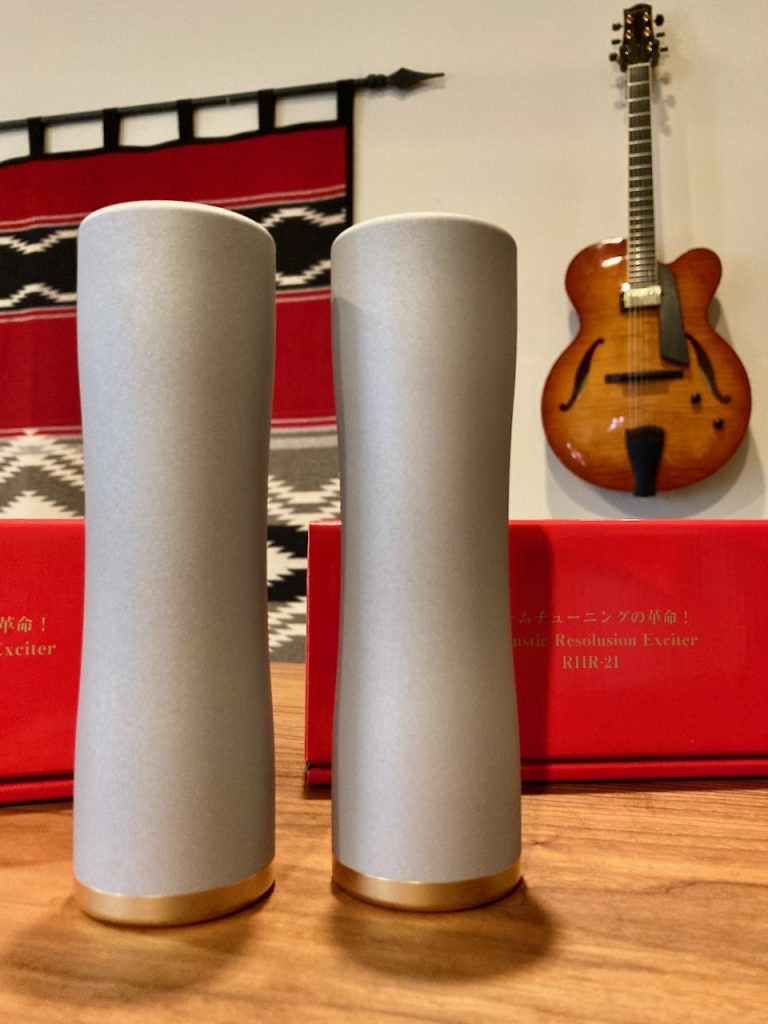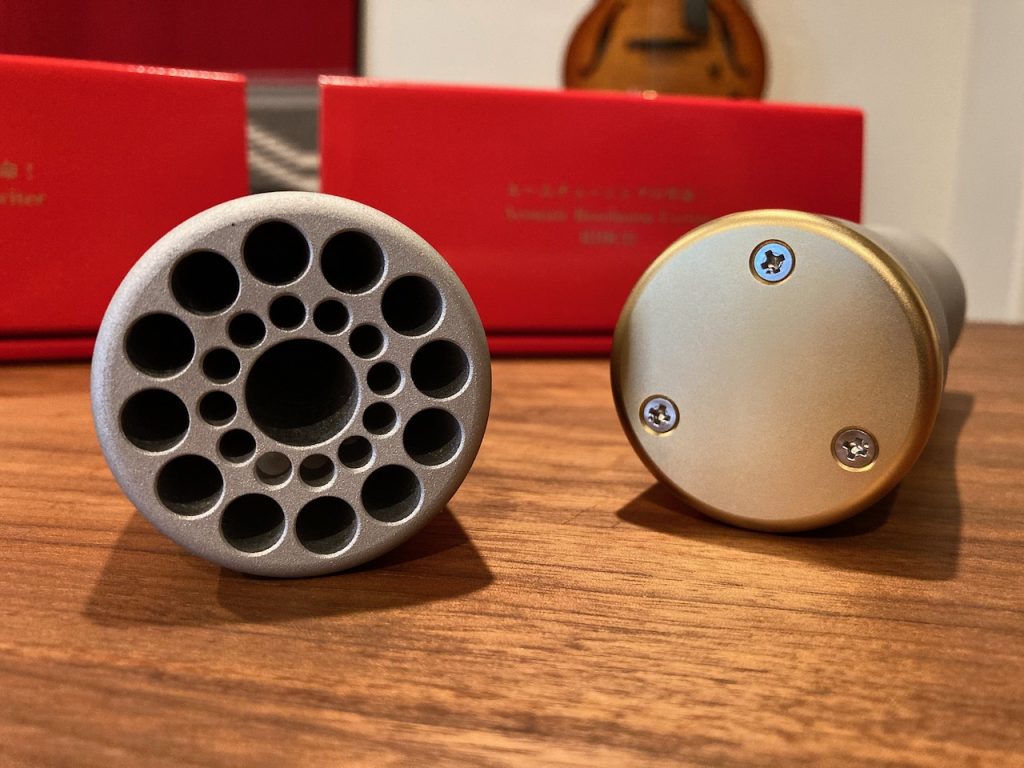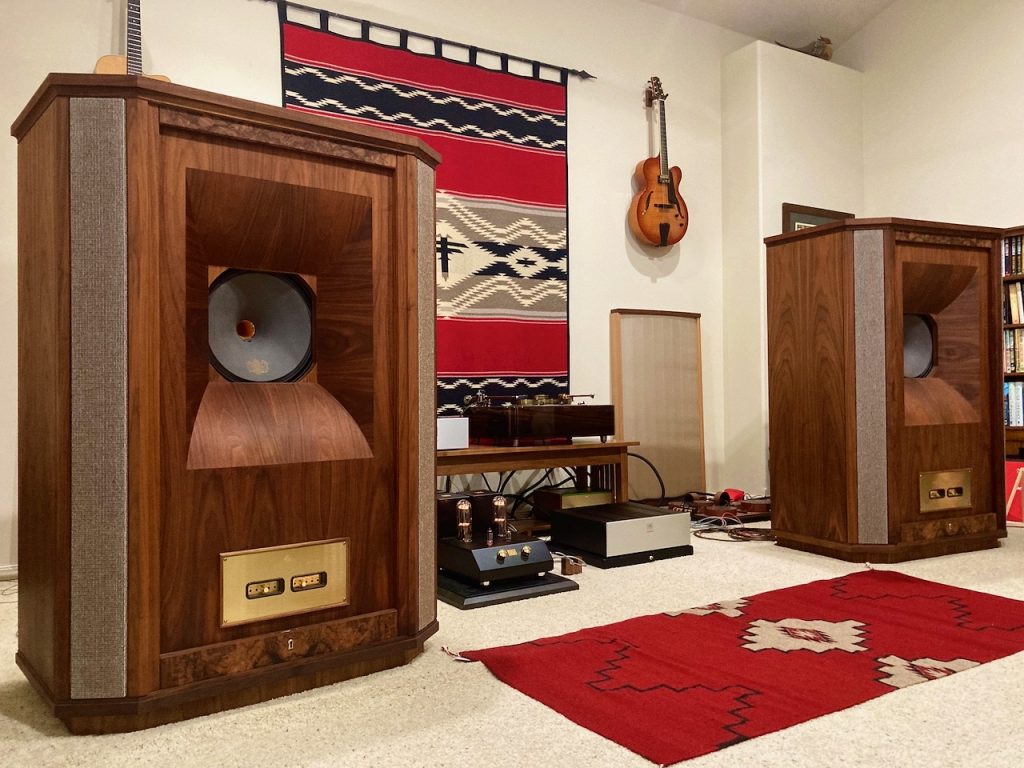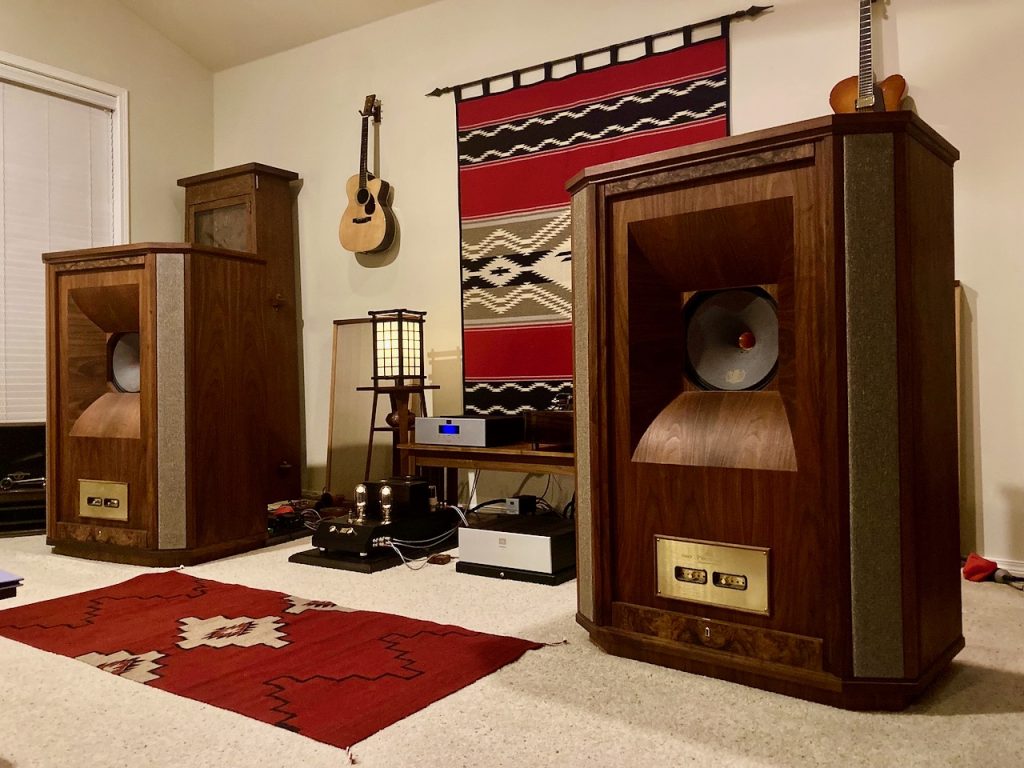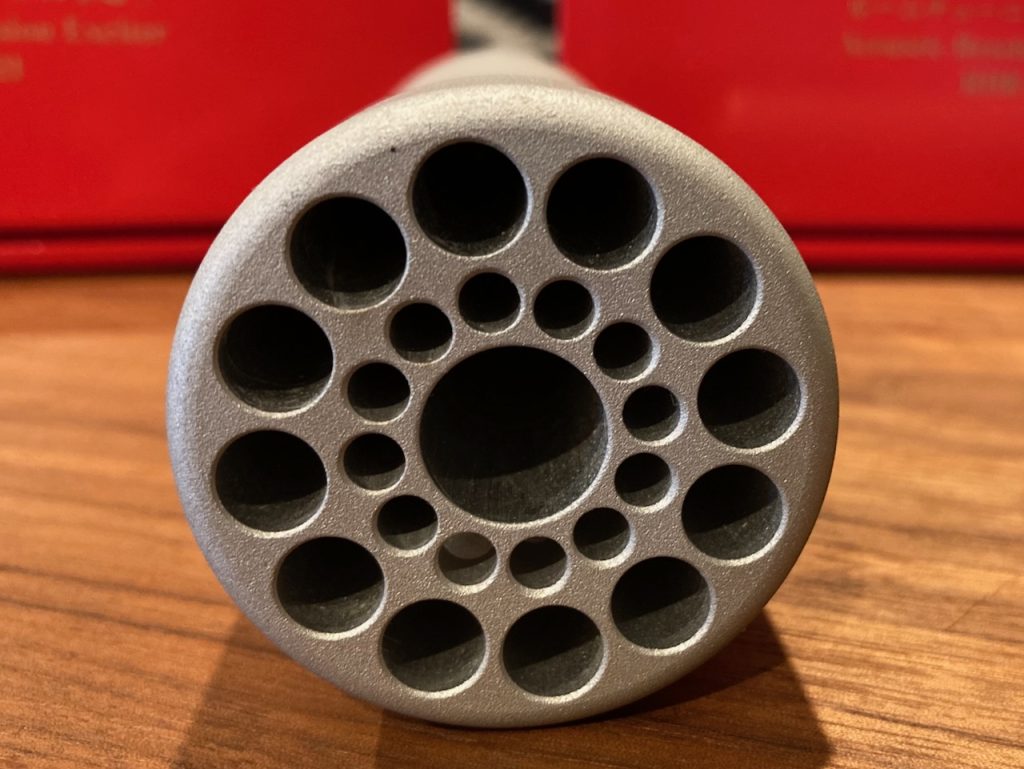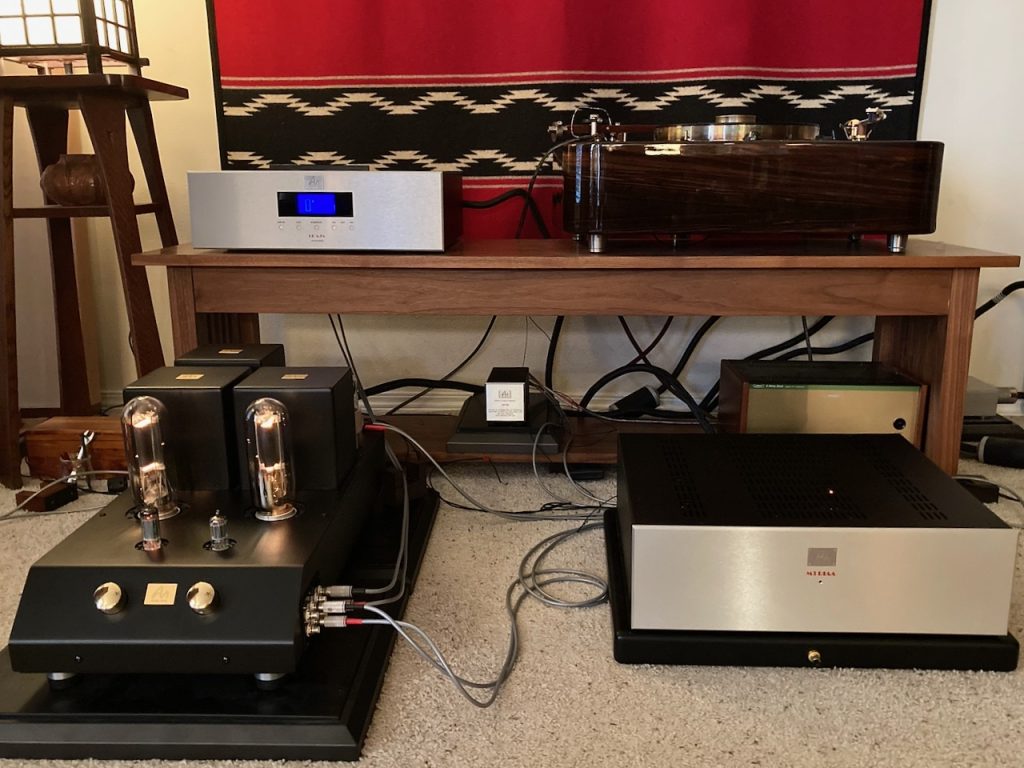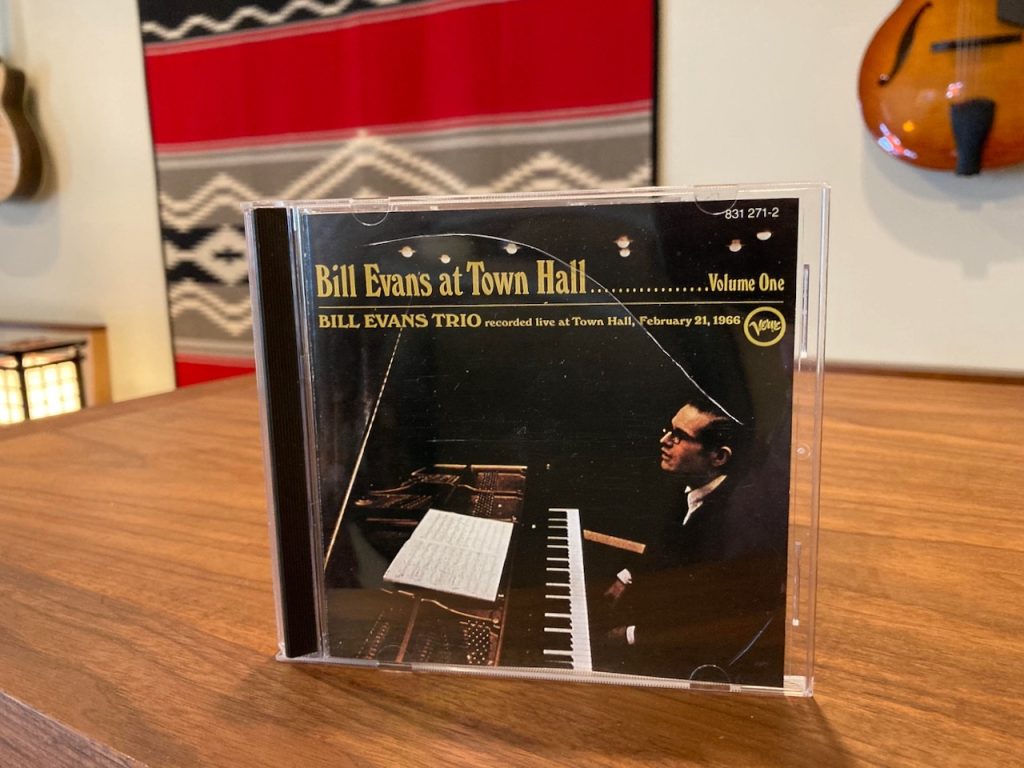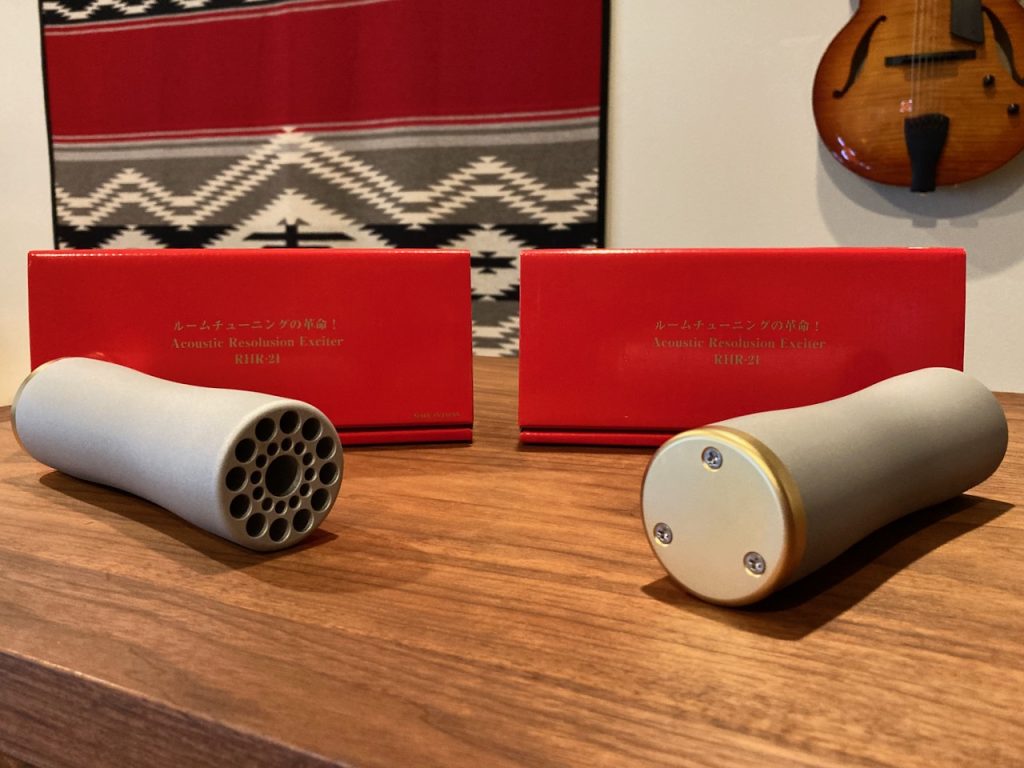Greetings friends, I hope you are well!
In my Today's Fresh Catch article from last month - here - I mentioned the Acoustic Revive RHR-21 Acoustic Resolution Exciter room conditioning devices.
The RHR-21s have a cylindrical shape reminiscent of Cole & Mason salt and pepper mill sets, and are about 6.75 inches in height, about 2 inches in diameter, and with each one weighing about 2 pounds.
The Acoustic Revive website doesn't discuss what materials the RHR-21 room tuning devices are made of, but they appear to be sand cast aluminum, with a series of concentric varied sized holes drilled/cast (?) into them to varying depths. On the bottom of each RHR-21 is a finely finished gold-colored base that is attached to the main cylinder with machine screws.
I'll ask Ken-san to clarify what the RHR-21s are made out of before their feature review.
Unlike the Cole & Mason mills, the RHR-21s aren't designed to grind, rather they are designed to refine the sound in your listening room.
The claims for the RHR-21 devices are that they have "a standing wave elimination effect" for a listening room that exceeds that of conventional room tuning devices, and "eliminates unnecessary reflections and band bias in the listening room".
Sound waves can reflect off of the floor, ceiling, and walls of a room. Lower frequencies with longer wavelengths can reflect off surfaces and interact with the direct sound waves from the loudspeakers, causing irregularities in the bass by cancelling/reenforcing bass frequencies at certain locations in the room.
With these long low-frequency waves a "standing wave" effect can occur in fixed positions of the room at frequencies that are multiples of the room's dimensions, resulting in boomy or weak bass response.
Typically, standing waves can affect frequencies up to about 300 Hz, and are more of an issue in smaller rooms - like the spare bedrooms used by many listeners - than in larger rooms.
I live in a smallish nuevo bungalow home, with my living room area serving as my primary listening room (it is 27’6’’ long by 20’4’’ wide, and with variable ceiling height from 9 to 20 feet).
The positioning of my Westminster loudspeakers is in a typical audiophile arrangement, with a modified rule of thirds/fifths sort of positioning.
The front of my West's are 77 inches out from the front wall, sides are 48 inches from the side walls, and the loudspeakers are 112 inches apart, center-to-center.
On the front wall behind each Westminster is an Acoustic Revive RWL-3 acoustic conditioning panel, and there is one RWL-3 panel located on the rear wall behind the listening position.
I have wool wall hangings on the front and side walls to help reduce sound reflections in the room. The room is carpeted which reduces sound reflections from the floor.
My listening position is about 12 feet from the Westminsters, and the rear wall is about 12 feet behind my listening 'couch'.
The rear of my living room behind the listening position opens to a combination kitchen/dining room, and is also open to an entryway on the right side wall.
This loudspeaker arrangement, in typical audiophile fashion, gives a wide and deep soundstage when playing magnetic or digital era stereo recordings, with exceptional imaging.
Initially, I tried placing the RHR-21s in various positions in my living room during casual listening while I was cooking, reading, or writing. I didn't hear any significant difference in the bass presentation of the music from my West's.
Then a non-audiophile friend stopped by to visit. He spotted the RHR-21s while we were chatting and listening to music, while enjoying a spot of Macallan 12, and asked me about them. I told him that they were passive devices that influenced the acoustic properties of the room.
I walked over to pick up the RHR-21s from their positions, and walked back to hand them to him for a look-see when I heard him utter a "Whoa!"
He heard a significant change in the room's sound as I walked across it with the RHR-21s in hand. That took me by surprise.
Hmm. Ahem. I decided I needed to be much more careful & methodical in my listening tests to better understand what the RHR-21s were doing. I should have paid closer attention to the recommendations of the user manual for positioning the RHR-21s. Blushing.
I decided I would start first with one RHR-21 and try it in each position recommended by the user manual, listen for any changes in system performance, and then I would move on and try two RHR-21s in the positions recommended by the user manual.
The associated components for my listening tests were the superlative combination of the Audio Note (UK) CD 5.1x CD player ($30,850.00 USD), the Audio Note (UK) Tomei 211 SET integrated amplifier ($59,587.00 USD, in for review), and a full complement of Audio Note (UK)'s silver interconnects and speaker cables connecting everything together.
I started my listening tests with the RHR-21 with a live recording of the Bill Evans Trio, Bill Evans At Town Hall.
My first listen was with no RHR-21 to serve as a baseline. Then I set up one RHR-21 about nine inches behind the centerline between the left & right loudspeakers (diagram below), being careful to orient it as the user manual describes, with the shallowest hole oriented towards my listening position.
My first impression was not that of a change in bass response like I was expecting, but rather as "I Should Care" began to play, there was a change in the way audience applause sounded.
The applause sounded more resolved, more natural, wider in the width dimension, and there was more of a sense of distance back into the depths of Town Hall. There was also a noticeable sense of the continuousness in the acoustic space of the recording between the audience and the musicians.
I also noticed that the instruments sounded more naturally live-like, and less like a recording of instruments, if that makes sense. Bill's piano, Chuck's bass, and Arnold's drums had more body, and more nuance. "Real sound", as Yazaki-san would say.
I repeated the 'with-without' test with the RHR-21 a couple of times to make sure I was hearing what I thought I was hearing, and yep, my impressions turned out the same each time.
The next position recommended by the user manual was forward on the centerline between the left & right loudspeakers, as in the digram above.
I listened to "Spring Is Here" without an RHR-21, then put the RHR-21 in position about 6 inches in front of the plane of the loudspeakers.
In this position the sound quality changed in a somewhat different direction, literally.
I noticed the front of the soundstage moved forward towards me, while the rear of the soundstage moved deeper into the back of soundstage, which gave a more spacious feel to the soundstage.
In this position I noticed the same enhanced sense of tonal naturalness, more body to the images, and a more "silky" presentation of nuance that I did in the previous position.
The music also sounded subjectively louder, even though there was no change in the volume setting at all.
The next position for the RHR-21 recommended by the user manual was in back of the equipment rack (as above).
So I did the same sort of 'with-without' drill using the RHR-21 while listening to "Who Can I Turn To", but with a variation.
There isn't much room behind my equipment rack with the wall being only eight inches away, so instead I sat the RHR-21 at the back of the equipment rack.
With the RHR-21 positioned at the back of the rack I heard a smoother overall presentation, but with a more compressed sense of images on the soundstage in the depth dimension. Almost 2D instead of 3D. Interestingly, Chuck Israels bass solo sounded more articulate and well defined in this position.
I didn't really care for this behind the rack position of the RHR-21.
The final recommendation of the user manual was to place the RHR-21 behind the listener, as in the diagram above.
I did the same 'with-without' comparison with the RHR-21 positioned about twenty-eight inches behind my listening position, while listening to "Make Someone Happy".
The first thing I noticed in this position was an increased sense of room-filling spaciousness for the Town Hall recording venue. The overall presentation became silkier sounding, more liquid, to provide a very open sense of the soundstage.
I liked this 'behind the listener' position.
Summing up, I didn't hear any significant change in bass response while using an RHR-21, like I was expecting to. Rather I heard changes from about 200-300 Hz on up.
I did notice that there was better resolution, more body to the images, an expanded soundstage, a more vivid sense of spaciousness at the recording venue, and a more natural "Real Sound" of the instruments.
There were moments in this recording where I thought I was hearing tape distortions, but they mostly disappeared with the RHR-21 in place.
I liked what I heard the RHR-21 doing in this audio system.
I'm starting to understand why the prestigious MJ Audio Technology journal in Japan gave Acoustic Revive an award for the RHR-21.
For such a simple looking and small device it had some surprising effects on sound quality.
In Part 2 of my "First Listen" I'll describe what I heard when using two RHR-21s.
In Part 3 of my "First Listen" I'll describe what I heard from RHR-21s in my vintage Altec A5 Voice of the Theatre audio-visual system, where the speakers are located in room boundary positions (corners).
Given the corner placement of the A5s, and having the listening/viewing position up against the rear wall, there's fewer options for placing the RHR-21s, but it should make for an interesting test of the RHR-21s for those who have loudspeakers oriented in a room boundary position.
Ok, that's it for now. As always, thanks for stopping by, and may the tone be with you!




